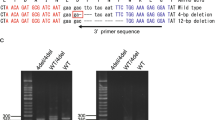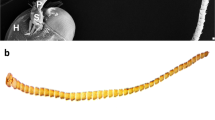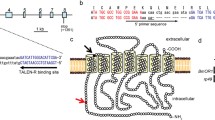Abstract
Pheromone reception is thought to be mediated by pheromone binding proteins (PBPs) in the aqueous lymph of the antennal sensilla. Recent studies have shown that the only known PBP of Bombyx mori (BmorPBP1) appears to be specifically tuned to bombykol but not to bombykal, raising the question of whether additional subtypes may exist. We have identified two novel genes, which encode candidate PBPs (BmorPBP2, BmorPBP3). Comparison with PBPs from various moth species have revealed a high degree of sequence identity and the three BmorPBP-subtypes can be assigned to distinct groups within the moth PBP family. In situ hybridization revealed that BmorPBP2 and BmorPBP3 are expressed only in relatively few cells compared to the number of cells expressing BmorPBP1. Double-labeling experiments have shown that the two novel BmorPBPs are expressed in the same cells but are not co-expressed with BmorPBP1. Furthermore, unlike BmorPBP1, cells expressing the newly identified PBPs did not surround neurons containing the BmOR-1 receptor. The results indicate that BmorPBP2 and BmorPBP3 are located in sensilla types, which are different from the long sensilla trichodea.







Similar content being viewed by others
Abbreviations
- BmorPBP:
-
Bombyx mori pheromone binding protein
- BmOR:
-
Bombyx mori olfactory receptor
- DIG:
-
Digoxigenin
References
Abraham D, Lofstedt C, Picimbon JF (2005) Molecular characterization and evolution of pheromone binding protein genes in Agrotis moths. Insect Biochem Mol Biol 35:1100–1111
Baker TC, Ochieng SA, Cosse AA, Lee SG, Todd JL, Quero C, Vickers NJ (2004) A comparison of responses from olfactory receptor neurons of Heliothis subflexa and Heliothis virescens to components of their sex pheromone. J Comp Physiol A 190:155–165
Bette S, Breer H, Krieger J (2002) Probing a pheromone binding protein of the silkmoth Antheraea polyphemus by endogenous tryptophan fluorescence. Insect Biochem Mol Biol 32:241–246
Blomquist GJ, Vogt RG (2003) Insect pheromone biochemistry and molecular biology. The biosynthesis and detection of pheromones and plant volatiles. Elsevier, London
Boeckh J, Kaissling KE, Schneider D (1965) Insect olfactory receptors. Cold Spring Harb Symp Quant Biol 30:263–280
Callahan FE, Vogt RG, Tucker ML, Dickens JC, Mattoo AK (2000) High level expression of “male specific” pheromone binding proteins (PBPs) in the antennae of female noctuiid moths. Insect Biochem Mol Biol 30:507–514
Feixas J, Prestwich GD, Guerrero A (1995) Ligand specificity of pheromone-binding proteins of the processionary moth. Eur J Biochem 234:521–526
Grosse-Wilde E, Svatos A, Krieger J (2006) A pheromone-binding protein mediates the bombykol-induced activation of a pheromone receptor in vitro. Chem Senses 31:547–555
Ha TS, Smith DP (2006) A pheromone receptor mediates 11-cis-vaccenyl acetate-induced responses in Drosophila. J Neurosci 26:8727–8733
Hansson BS (1995) Olfaction in Lepidoptera. Experientia 51:1003–1027
Hillier NK, Kleineidam C, Vickers NJ (2005) Physiology and glomerular projections of olfactory receptor neurons on the antenna of female Heliothis virescens (Lepidoptera: Noctuidae) responsive to behaviorally relevant odors. J Comp Physiol A Neuroethol Sens Neural Behav Physiol 192(2):199–219
Howard RW, Blomquist GJ (2005) Ecological, behavioral, and biochemical aspects of insect hydrocarbons. Annu Rev Entomol 50:371–393
Kaissling K-E (1987) Colbow K (eds) R.H. Wright Lectures on insect olfaction. Simon Fraser University, Burnaby, pp 1–75
Kaissling K-E, Kasang G, Bestmann HJ, Stransky W, Vostrowsky O (1978) A new pheromone of the silkworm moth Bombyx mori. Naturwissenschaften 65:382–384
Krieger J, Gaenssle H, Raming K, Breer H (1993) Odorant binding proteins of Heliothis virescens. Insect Biochem Mol Biol 23:449–456
Krieger J, Grosse-Wilde E, Gohl T, Breer H (2005) Candidate pheromone receptors of the silkmoth Bombyx mori. Eur J Neurosci 21:2167–2176
Krieger J, Nickisch-Rosenegk E, Mameli M, Pelosi P, Breer H (1996) Binding proteins from the antennae of Bombyx mori. Insect Biochem Mol Biol 26:297–307
Krieger J, Raming K, Breer H (1991) Cloning of genomic and complementary DNA encoding insect pheromone binding proteins: evidence for microdiversity. Biochim Biophys Acta 1088:277–284
Krieger J, Raming K, Dewer YM, Bette S, Conzelmann S, Breer H (2002) A divergent gene family encoding candidate olfactory receptors of the moth Heliothis virescens. Eur J Neurosci 16:619–628
Kumar S, Tamura K, Jakobsen IB, Nei M (2001) MEGA2: molecular evolutionary genetics analysis software. Bioinformatics 17:1244–1245
Maida R, Krieger J, Gebauer T, Lange U, Ziegelberger G (2000) Three pheromone-binding proteins in olfactory sensilla of the two silkmoth species Antheraea polyphemus and Antheraea pernyi. Eur J Biochem 267:2899–2908
Maida R, Mameli M, Muller B, Krieger J, Steinbrecht RA (2005) The expression pattern of four odorant-binding proteins in male and female silk moths, Bombyx mori. J Neurocytol 34:149–163
Maida R, Steinbrecht RA, Ziegelberger G, Pelosi P (1993) The pheromone binding protein of Bombyx mori: Purification, characaterization and immunocytochemical localization. Insect Biochem Molec Biol 23:243–253
Maida R, Ziegelberger G, Kaissling KE (2003) Ligand binding to six recombinant pheromone-binding proteins of Antheraea polyphemus and Antheraea pernyi. J Comp Physiol [B] 173:565–573
Mita K, Kasahara M, Sasaki S, Nagayasu Y, Yamada T, Kanamori H, Namiki N, Kitagawa M, Yamashita H, Yasukochi H, Kadono-Okuda K, Yamamoto K, Ajimura M, Ravikumar G, Shimomura M, Nagamura Y, Shin-I T, Abe H, Shimada T, Morishita S, Sasaki T (2004) The genome sequence of silkworm, Bombyx mori. DNA Res 11:27–25
Mohl C, Breer H, Krieger J (2002) Species-specific pheromonal compounds induce distinct conformational changes of pheromone binding protein subtypes from Antheraea polyphemus. Invert Neurosci 4:165–174
Nakagawa T, Sakurai T, Nishioka T, Touhara K (2005) Insect sex-pheromone signals mediated by specific combinations of olfactory receptors. Science 307:1638–1642
Nesbitt BF, Beevor PS, Cole RA, Lester R, Poppi RG (1973) Sex pheromones of two noctuid moths. Nat New Biol 244:208–209
Pelosi P, Zhou JJ, Ban LP, Calvello M (2006) Soluble proteins in insect chemical communication. Cell Mol Life Sci 63:1658–1676
Picimbon JF, Gadenne C (2002) Evolution of noctuid pheromone binding proteins: identification of PBP in the black cutworm moth, Agrotis ipsilon. Insect Biochem Mol Biol 32:839–846
Plettner E, Lazar J, Prestwich EG, Prestwich GD (2000) Discrimination of pheromone enantiomers by two pheromone binding proteins from the gypsy moth Lymantria dispar. Biochemistry 39:8953–8962
Robertson HM, Martos R, Sears CR, Todres EZ, Walden KK, Nardi JB (1999) Diversity of odourant binding proteins revealed by an expressed sequence tag project on male Manduca sexta moth antennae. Insect Mol Biol 8:501–518
Sakurai T, Nakagawa T, Mitsuno H, Mori H, Endo Y, Tanoue S, Yasukochi Y, Touhara K, Nishioka T (2004) Identification and functional characterization of a sex pheromone receptor in the silkmoth Bombyx mori. Proc Natl Acad Sci USA 101:16653–16658
Sandler BH, Nikonova L, Leal WS, Clardy J (2000) Sexual attraction in the silkworm moth: structure of the pheromone-binding-protein–bombykol complex. Chem Biol 7:143–151
Schneider D (1992) 100 years of pheromone research. An essay on lepidoptera. Naturwissenschaften 79:241–250
Schneider D, Kaissling K-E (1957) Der Bau der Antenne des Seidenspinners Bombyx mori L. II. Sensillen, cuticulare Bildungen und innerer Bau. In: Zoologische Jahrbücher, VEB Gustav Fischer Verlag, Jena, pp 223–250
Schneider D, Schulz S, Priesner E, Ziesmann J, Francke W (1998) Autodetection and chemistry of female and male pheromone in both sexes of the tiger moth Panaxia quadripunctaria. J Comp Physiol A 182:153–161
Schweitzer ES, Sanes JR, Hildebrand JG (1976) Ontogeny of electroantennogram responses in the moth, Manduca sexta. J Insect Physiol 22:955–960
Steinbrecht RA (1970) Zur Morphometrie der Antenne des Seidenspinners, Bombyx mori L.: Zahl und Verteilung der Riechsensillen (Insecta, Lepidoptera). Z Morph Tiere 68:93–126
Steinbrecht RA (1973) Der Feinbau olfaktorischer Sensillen des Seidenspinners (Insecta, Lepidoptera) Rezeptorfortsätze und reizleitender Apparat. Zeitschrift für Zellforschung 139:533–565
Steinbrecht RA (1999) Olfactory receptors. In: Eguchi E, Tominaga Y (eds) Atlas of arthropod sensory receptors. Dynamic morphology in relation to function, Springer, Tokyo, pp 155–176
Steinbrecht RA, Ozaki M, Ziegelberger G (1992) Immunocytochemical localization of pheromone-binding protein in moth antennae. Cell Tissue Res 270:287–302
Tanaka T, Kuwano Y, Kuzumaki T, Ishikawa K, Ogata K (1987) Nucleotide sequence of cloned cDNA specific for rat ribosomal protein L31. Eur J Biochem 162:45–48
Thompson JD, Higgins DG, Gibson TJ (1994) CLUSTAL W: improving the sensitivity of progressive multiple sequence alignment through sequence weighting, position-specific gap penalties and weight matrix choice. Nucleic Acids Res 22:4673–4680
Vogt RG (2003) Biochemical diversity of odor detection: OBPs, ODEs and SNMPs. In: Blomquist G, Vogt RG (eds) Insect pheromone biochemistry and molecular biology. The biosynthesis and detection of pheromones and plant volatiles, Elsevier, London, pp 391–445
Vogt RG, Rogers ME, Franco MD, Sun M (2002) A comparative study of odorant binding protein genes: differential expression of the PBP1-GOBP2 gene cluster in Manduca sexta (Lepidoptera) and the organization of OBP genes in Drosophila melanogaster (Diptera). J Exp Biol 205:719–744
Wang J, Xia Q, He X, Dai M, Ruan J, Chen J, Yu G, Yuan H, Hu Y, Li R, Feng T, Ye C, Lu C, Wang J, Li S, Wong GK, Yang H, Wang J, Xiang Z, Zhou Z, Yu J (2005) SilkDB: a knowledgebase for silkworm biology and genomics. Nucleic Acids Res 33:D399–D402
Xu PX, Atkinson R, Jones DNM, Smith DP (2005) Drosophila OBP LUSH is required for activity of pheromone-sensitive neurons. Neuron 45:193–200
Acknowledgments
This work was supported by the Deutsche Forschungsgemeinschaft (grant KR1786/3).
Author information
Authors and Affiliations
Corresponding author
Additional information
Data deposition: The sequences reported in this paper have been deposited in the EMBL database under accession nos. AM403100 (BmorPBP2) and AM403101 (BmorPBP3).
Rights and permissions
About this article
Cite this article
Forstner, M., Gohl, T., Breer, H. et al. Candidate pheromone binding proteins of the silkmoth Bombyx mori . Invert Neurosci 6, 177–187 (2006). https://doi.org/10.1007/s10158-006-0032-0
Received:
Accepted:
Published:
Issue Date:
DOI: https://doi.org/10.1007/s10158-006-0032-0




